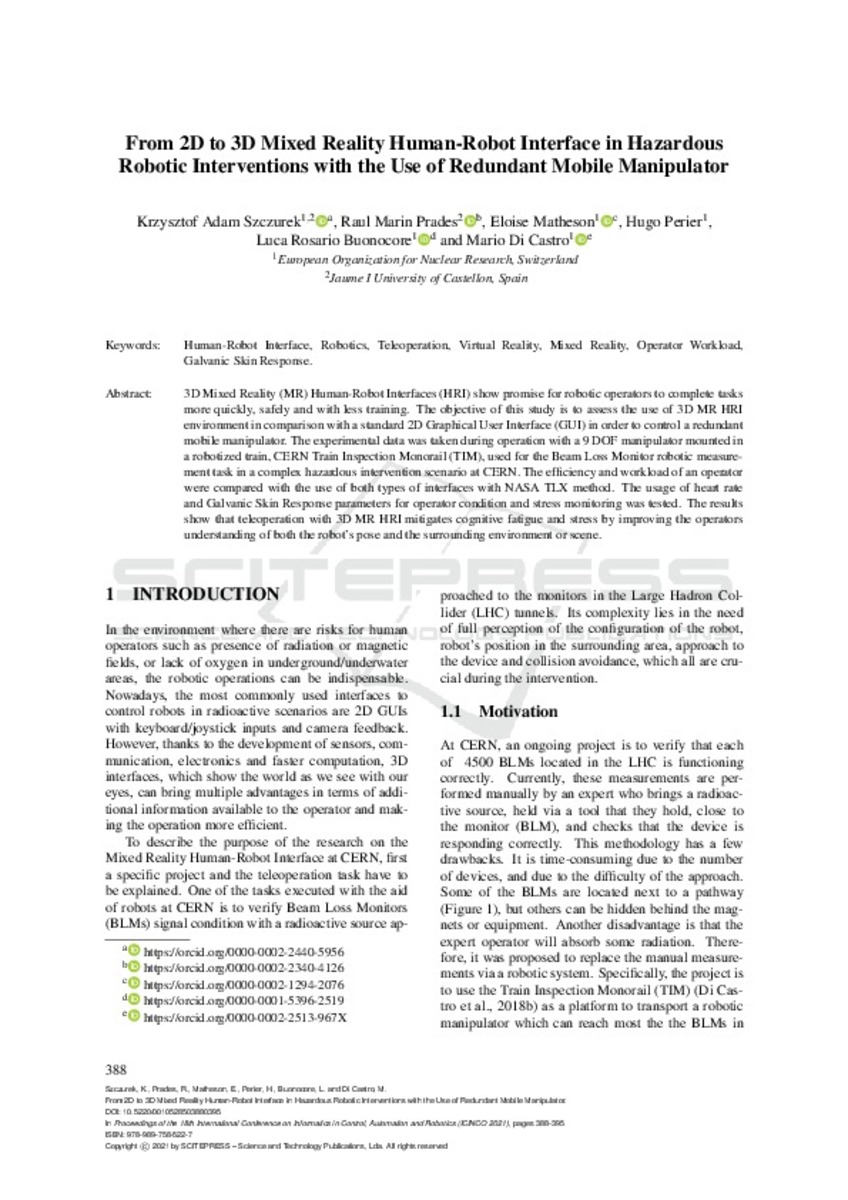Mostrar el registro sencillo del ítem
From 2D to 3D Mixed Reality Human-Robot Interface in Hazardous Robotic Interventions with the Use of Redundant Mobile Manipulator
| dc.contributor.author | Szczurek, Krzysztof Adam | |
| dc.contributor.author | Marin, Raul | |
| dc.contributor.author | Matheson, Eloise | |
| dc.contributor.author | Perier, Hugo | |
| dc.contributor.author | Buonocore, Luca Rosario | |
| dc.contributor.author | Di Castro, Mario | |
| dc.date.accessioned | 2022-11-28T14:41:03Z | |
| dc.date.available | 2022-11-28T14:41:03Z | |
| dc.date.issued | 2021 | |
| dc.identifier.citation | Szczurek, K.; Prades, R.; Matheson, E.; Perier, H.; Buonocore, L. and Di Castro, M. (2021). From 2D to 3D Mixed Reality Human-Robot Interface in Hazardous Robotic Interventions with the Use of Redundant Mobile Manipulator. In Proceedings of the 18th International Conference on Informatics in Control, Automation and Robotics - ICINCO, ISBN 978-989-758-522-7; ISSN 2184-2809, pages 388-395. DOI: 10.5220/0010528503880395 | ca_CA |
| dc.identifier.isbn | 9789897585227 | |
| dc.identifier.issn | 2184-2809 | |
| dc.identifier.uri | http://hdl.handle.net/10234/200952 | |
| dc.description | Part de la conferència: ICINCO 2021: 18th International Conference on Informatics in Control, Automation and Robotics (juliol 2021) | ca_CA |
| dc.description.abstract | 3D Mixed Reality (MR) Human-Robot Interfaces (HRI) show promise for robotic operators to complete tasks more quickly, safely and with less training. The objective of this study is to assess the use of 3D MR HRI environment in comparison with a standard 2D Graphical User Interface (GUI) in order to control a redundant mobile manipulator. The experimental data was taken during operation with a 9 DOF manipulator mounted in a robotized train, CERN Train Inspection Monorail (TIM), used for the Beam Loss Monitor robotic measurement task in a complex hazardous intervention scenario at CERN. The efficiency and workload of an operator were compared with the use of both types of interfaces with NASA TLX method. The usage of heart rate and Galvanic Skin Response parameters for operator condition and stress monitoring was tested. The results show that teleoperation with 3D MR HRI mitigates cognitive fatigue and stress by improving the operators understanding of both the robot’s pose and the surr ounding environment or scene. | ca_CA |
| dc.format.extent | 8 p. | ca_CA |
| dc.format.mimetype | application/pdf | ca_CA |
| dc.language.iso | eng | ca_CA |
| dc.publisher | SCITEPRESS – Science and Technology Publications, Lda. | ca_CA |
| dc.relation.isPartOf | Proceedings of the 18th International Conference on Informatics in Control, Automation and Robotics (ICINCO 2021) | ca_CA |
| dc.rights | © 2021 SciTePress, Science and Technology Publications, Lda - All rights reserved. | ca_CA |
| dc.rights.uri | http://creativecommons.org/licenses/by-nc-nd/4.0/ | ca_CA |
| dc.subject | Human-Robot Interface | ca_CA |
| dc.subject | robotics | ca_CA |
| dc.subject | teleoperation | ca_CA |
| dc.subject | virtual reality | ca_CA |
| dc.subject | mixed reality | ca_CA |
| dc.subject | operator workload | ca_CA |
| dc.subject | galvanic skin response | ca_CA |
| dc.title | From 2D to 3D Mixed Reality Human-Robot Interface in Hazardous Robotic Interventions with the Use of Redundant Mobile Manipulator | ca_CA |
| dc.type | info:eu-repo/semantics/conferenceObject | ca_CA |
| dc.identifier.doi | 10.5220/0010528503880395 | |
| dc.rights.accessRights | info:eu-repo/semantics/openAccess | ca_CA |
| dc.relation.publisherVersion | https://www.scitepress.org/Link.aspx?doi=10.5220/0010528503880395 | ca_CA |
| dc.type.version | info:eu-repo/semantics/publishedVersion | ca_CA |








